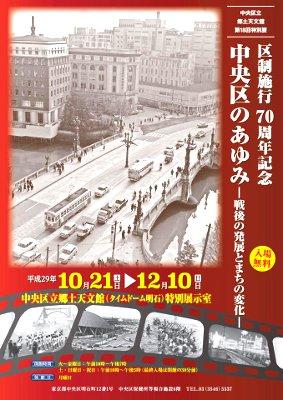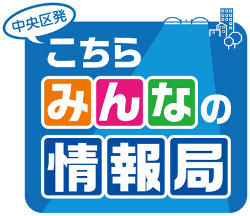At the Chuo Ward Folk Tenmonkan (Time Dome Akashi), special exhibition "Ayumi in Chuo-ku, commemorating the 70th anniversary of the enforcement of the ward system-development and changes in towns-" began on October 21 (Saturday). This year marks the 70th anniversary of the birth of Chuo-ku, and it features Ayumi of the development of Chuo-ku from post-war reconstruction to today. The exhibition period is closed on Monday until Sunday, December 10 and admission is free. Click here.>>
 Chuo-ku was born on March 15, 1947 (1947). At that time, under the occupation of the Allied Forces, the main buildings in the ward were seized, and the general public lived a tough life after the end of the war. Under such circumstances, measures aimed at post-war reconstruction are on display. It is such as organizing the Ginza open-air street and reclamation of rivers. In 1952, the restoration of Japan's sovereignty led to the path to economic development.
Chuo-ku was born on March 15, 1947 (1947). At that time, under the occupation of the Allied Forces, the main buildings in the ward were seized, and the general public lived a tough life after the end of the war. Under such circumstances, measures aimed at post-war reconstruction are on display. It is such as organizing the Ginza open-air street and reclamation of rivers. In 1952, the restoration of Japan's sovereignty led to the path to economic development.
At the Tokyo Olympics held in 1964 (1964), infrastructure development for urban renovation was mainly carried out, and construction of the Metropolitan Expressway was a representative measure. At the same time, transportation, such as the opening of the subway, was also a turning point from conventional shipping to land transportation. Urban development in the coastal area east of Tsukishima is also progressing. The construction of Harumi Wharf and the opening of an international trade fair venue can be seen, indicating the departure from industrialization.
The exhibition features the growth and changes of the Kabuto-cho financial district and the prosperity of the department stores as the bustling city of Chuo-ku as a commercial district. I look at the city that has been reborn as a result of active redevelopment from then to recent years.
The special exhibition exhibition featured some of the postwar development of Chuo-ku, which seemed to focus more on infrastructure and hardware. The major change after the end of the war was the creation of a free society. Culture and education policies have changed dramatically. There were many movie companies, movie theaters, and popular entertainment facilities in Chuo-ku. In addition, it is a place where media relations such as newspapers and television-related gather as information dissemination bases. We must not forget such a point of view. @ Akira Makibuchi
 The title of the work in the October 2017 issue
The title of the work in the October 2017 issue
